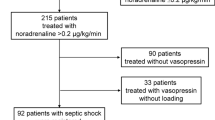Abstract
Purpose
To compare the effects of two arginine vasopressin (AVP) dose regimens on the hemodynamic response, catecholamine requirements, AVP plasma concentrations, organ function and adverse events in advanced vasodilatory shock.
Methods
In this prospective, controlled, open-label trial, patients with vasodilatory shock due to sepsis, systemic inflammatory response syndrome or after cardiac surgery requiring norepinephrine >0.6 μg/kg/min were randomized to receive a supplementary AVP infusion either at 0.033 IU/min (n = 25) or 0.067 IU/min (n = 25). The hemodynamic response, catecholamine doses, laboratory and organ function variables as well as adverse events (decrease in cardiac index or platelet count, increase in liver enzymes or bilirubin) were recorded before, 1, 12, 24 and 48 h after randomization. A linear mixed effects model was used for statistical analysis in order to account for drop-outs during the observation period.
Results
Heart rate and norepinephrine requirements decreased while MAP increased in both groups. Patients receiving AVP at 0.067 IU/min required less norepinephrine (P = 0.006) than those infused with AVP at 0.033 IU/min. Arterial lactate and base deficit decreased while arterial pH increased in both groups. During the observation period, AVP plasma levels increased in both groups (both P < 0.001), but were higher in the 0.067 IU/min group (P < 0.001) and in patients on concomitant hydrocortisone. The rate of adverse events and intensive care unit mortality was comparable between groups (0.033 IU/min, 52%; 0.067 IU/min, 52%; P = 1).
Conclusions
A supplementary AVP infusion of 0.067 IU/min restores cardiovascular function in patients with advanced vasodilatory shock more effectively than AVP at 0.033 IU/min.



Similar content being viewed by others
References
Landry DW, Levin HR, Gallant EM, Seo S, D’Alessandro D, Oz MC, Oliver JA (1997) Vasopressin pressor hypersensitivity in vasodilatory septic shock. Crit Care Med 25:1279–1282
Mutlu GM, Factor P (2004) Role of vasopressin in the management of septic shock. Intens Care Med 30:1276–1291
Lange M, Ertmer C, Westphal M (2008) Vasopressin vs. terlipressin in the treatment of cardiovascular failure in sepsis. Intens Care Med 34:821–832
Jerath N, Frndova H, McCrindle BW, Gurofsky R, Humpl T (2008) Clinical impact of vasopressin infusion on hemodynamics, liver and renal function in pediatric patients. Intens Care Med 34:1274–1280
Dünser MW, Mayr AJ, Ulmer H, Ritsch N, Knotzer H, Pajk W, Luckner G, Mutz NJ, Hasibeder WR (2001) The effects of vasopressin on systemic hemodynamics in catecholamine-resistant septic and postcardiotomy shock: a retrospective analysis. Anesth Analg 93:7–13
Luckner G, Dünser MW, Jochberger S, Mayr VD, Wenzel V, Ulmer H, Schmid S, Knotzer H, Pajk W, Hasibeder W, Mayr AJ, Friesenecker B (2005) Arginine vasopressin in 316 patients with advanced vasodilatory shock. Crit Care Med 33:2659–2666
Dünser MW, Mayr AJ, Hanno U, Knotzer H, Sumann G, Pajk W, Friesenecker B, Hasibeder WR (2003) Arginine vasopressin in advanced vasodilatory shock: a prospective, randomized, controlled study. Circulation 107:2313–2319
Russell JA, Walley KR, Singer J, Gordon AC, Hébert PC, Cooper DJ, Holmes CL, Mehta S, Granton JT, Storms MM, Cook DJ, Presneill JJ, Ayers D, VASST Investigators (2008) Vasopressin versus norepinephrine infusion in patients with septic shock. N Engl J Med 358:877–887
Russell JA, Walley KR, Gordon AC, Cooper DJ, Hébert PC, Singer J, Holmes CL, Mehta S, Granton JT, Storms MM, Cook DJ, Presneill JJ, Dieter Ayers for the Vasopressin, Septic Shock Trial Investigators (2009) Interaction of vasopressin infusion, corticosteroid treatment and mortality of septic shock. Crit Care Med 37:811–818
Dellinger RP, Levy MM, Carlet JM, Bion J, Parker MM, Jaeschke R, Reinhart K, Angus DC, Brun-Buisson C, Beale R, Calandra T, Dhainaut JF, Gerlach H, Harvey M, Marini JJ, Marshall J, Ranieri M, Ramsay G, Sevransky J, Thompson BT, Townsend S, Vender JS, Zimmerman JL, Vincent JL (2008) Surviving Sepsis Campaign: international guidelines for management of severe sepsis and septic shock: 2008. Intens Care Med 34:17–60
Klinzing S, Simon M, Reinhart K, Bredle DL, Meier-Hellmann A (2003) High-dose vasopressin is not superior to norepinephrine in septic shock. Crit Care Med 31:2646–2650
Luckner G, Mayr VD, Jochberger S, Wenzel V, Ulmer H, Hasibeder WR, Dünser MW (2007) Comparison of two dose regimes of arginine vasopressin in advanced vasodilatory shock. Crit Care Med 35:2280–2285
American College of Chest Physicians/Society of Critical Care Medicine Consensus Conference (1992) Definitions for sepsis and organfailure and guidelines for the use of innovative therapies in sepsis. Crit Care Med 20:864–874
Goris RJA, te Boekhorst TPA, Nuytinck JKS, Gimbrère JS (1985) Multiple-organ failure. Arch Surg 120:1109–1115
Vincent JL, Moreno R, Takala J, Willatts S, De Mendonça A, Bruining H, Reinhart CK, Suter PM, Thijs LG (1996) The SOFA (Sepsis-related Organ Failure Assessment) score to describe organ dysfunction/failure. On behalf of the Working Group on Sepsis-Related Problems of the European Society of Intensive Care Medicine. Intens Care Med 22:707–710
Beardwell CG (1971) Radioimmunoassay of arginine vasopressin in human plasma. J Clin Endocrinol Metab 33:254–260
Laird NM, Ware JH (1982) Random effects models for longitudinal data. Biometrics 38:963–974
Holmes CL, Walley KR, Chittock DR, Lehman T, Russell JA (2001) The effects of vasopressin on hemodynamics and renal function in severe septic shock: a case series. Intens Care Med 27:1416–1421
Dünser MW, Hasibeder WR (2009) Sympathetic overstimulation during critical illness: adverse effects of adrenergic stress. J Intensive Care Med, 23 Aug [Epub ahead of print]
Goldspink DF, Burniston JG, Ellison GM, Clark WA, Tan LB (2004) Catecholamine-induced apoptosis and necrosis in cardiac and skeletal myocytes of the rat in vivo: the same or separate death pathways? Exp Physiol 89:407–416
Paradis C (2008) Bias in surgical research. Ann Surg 248:180–188
Conflict of interest statement
No author has a conflict of interest in regards to the drugs or methods discussed in this manuscript.
Author information
Authors and Affiliations
Corresponding author
Rights and permissions
About this article
Cite this article
Torgersen, C., Dünser, M.W., Wenzel, V. et al. Comparing two different arginine vasopressin doses in advanced vasodilatory shock: a randomized, controlled, open-label trial. Intensive Care Med 36, 57–65 (2010). https://doi.org/10.1007/s00134-009-1630-1
Received:
Revised:
Accepted:
Published:
Issue Date:
DOI: https://doi.org/10.1007/s00134-009-1630-1




